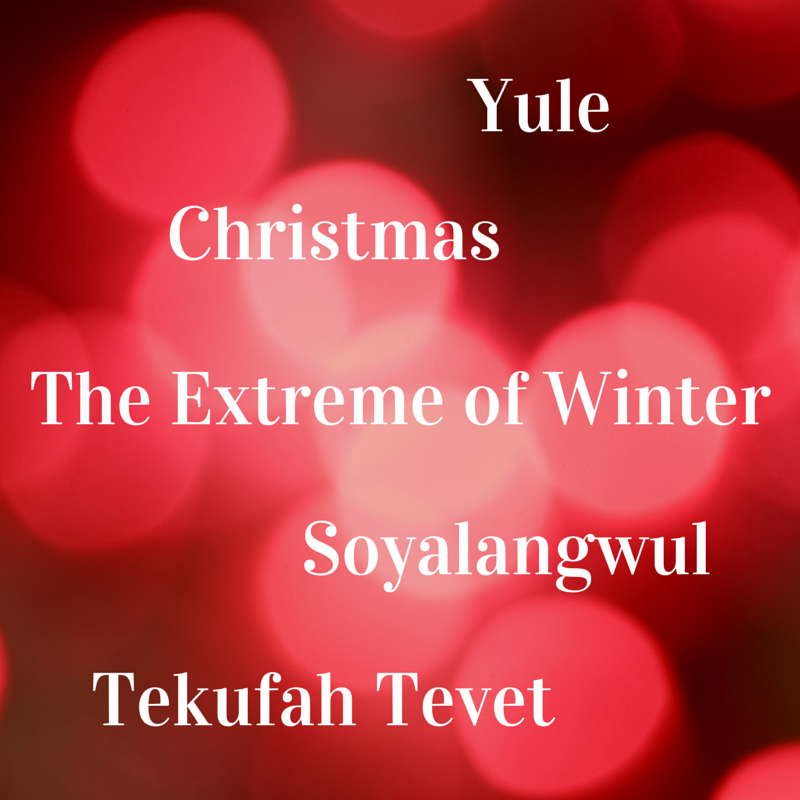This morning I received the December 2014 L7 Lifestyles newsletter from Lotus 7 Yoga, a local Rancho Santa Margarita, CA yoga studio. The newsletter summarized different mid-winter celebrations. The newsletter motivated me to finally get off the couch, go to the studio, and take a gentle restorative yoga class. Here I quote the newsletter regarding the world’s major winter festivals:
Soyalangwul (Native Amercan) is the winter ceremony of the Zuni and the Hopitu Shinumu, “The Peaceful Ones,” also known as the Hopi Indians. The main purpose of the ritual is to ceremonially bring the sun back from its long winter slumber. It also marks the beginning of another cycle of the Wheel of the Year, and is a time for purification. Pahos (prayer sticks) are made prior to the Soyal ceremony, to bless all the community, including their homes, animals, and plants. The kivas (sacred underground ritual chambers) are ritually opened to mark the beginning of the Kachina season.
Tekufah Tevet (Hebrew) is one of four Tekufot, solstices and equinoxes recognized by the Talmudical writers. Tekufat, the beginning of winter, or “‘et ha-koref” (stripping-time) was when Jephthah sacrificed his daughter . A long standing superstition is that on any of the Tekufot, water that was kept in vessels turned poisonous and must be thrown out. Some believed the poisoning could be prevented by placing iron in the water over the Tekufot. This observation’s solemnness is unlike the following holiday, Hanukkah. This celebration carries much of the ‘light’ symbolism present in solstice-connected holidays and has become more prominent in western cultures.
The Extreme of Winter (Chinese, Japanese, Korean, Vietnamese) is one of the most important festivals celebrated by the Chinese and other East Asians when sunshine is weakest and daylight shortest; i.e., on the first day of the dongzhi solar term. The origins of this festival can be traced back to the yin and yang philosophy of balance and harmony in the cosmos. After this celebration, there will be days with longer daylight hours and therefore an increase in positive energy flowing in. The philosophical significance of this is symbolized by the I Ching hexagram fù (“Returning”). Traditionally, the Dongzhi Festival is also a time for the family to get together.
Christmas or Christ’s Mass is one of the most popular Christian celebrations as well as one of the most globally recognized midwinter celebrations. Christmas is the celebration of the birth of the God Incarnate or Messiah, later known as Jesus Christ. The birth is observed on December 25, which was the winter solstice upon establishment of the Julian Calendar. Universal activities include feasting, midnight masses, good deeds and gift giving in the tradition of St. Nicholas by not admitting to being the actual gift giver.
Yule or Jul (Northern Europe, Scandinavian, Norse and Germanic) In 960, King Håkon of Norway signed into law that ‘Jul’ was to be celebrated on the night leading into December 25, to align it with the Christian celebrations. Yule logs were lit to honor Thor, the god of thunder. Feasting would continue until the log burned out, three or as many as twelve days. Early Germans (c.500-1000) considered the Norse goddess, Hertha or Bertha to be the goddess of light, domesticity and the home. They baked yeast cakes shaped like shoes, which were called Hertha’s slippers, and filled with gifts. During the Winter Solstice houses were decked with fir and evergreens to welcome her coming. When the family and serfs were gathered to dine, a great altar of flat stones was erected and here a fire of fir boughs was laid.
Resources: Wikipedia.com


Leave a Reply